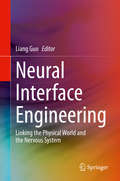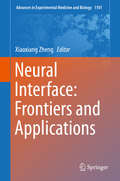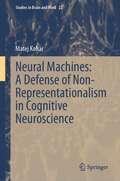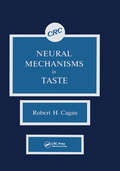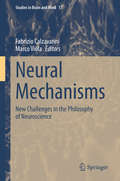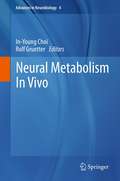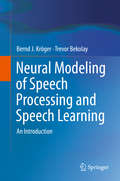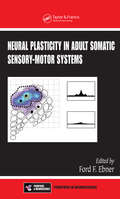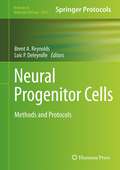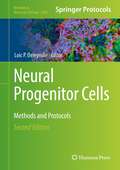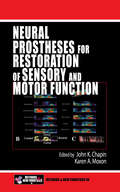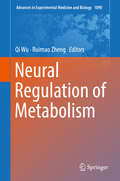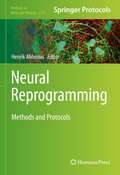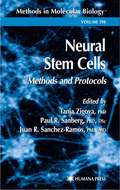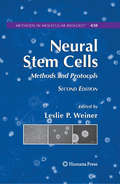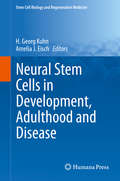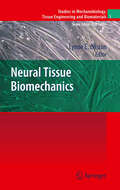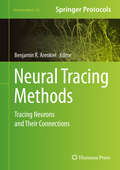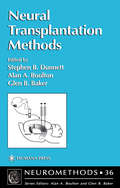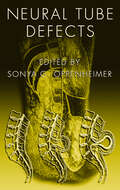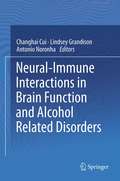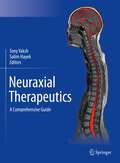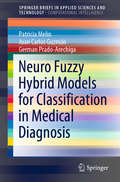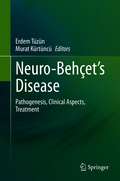- Table View
- List View
Neural Interface Engineering: Linking the Physical World and the Nervous System
by Liang GuoThis book provides a comprehensive reference to major neural interfacing technologies used to transmit signals between the physical world and the nervous system for repairing, restoring and even augmenting body functions. The authors discuss the classic approaches for neural interfacing, the major challenges encountered, and recent, emerging techniques to mitigate these challenges for better chronic performances. Readers will benefit from this book’s unprecedented scope and depth of coverage on the technology of neural interfaces, the most critical component in any type of neural prostheses.Provides comprehensive coverage of major neural interfacing technologies;Reviews and discusses both classic and latest, emerging topics;Includes classification of technologies to provide an easy grasp of research and trends in the field.
Neural Interface: Frontiers and Applications (Advances in Experimental Medicine and Biology #1101)
by Xiaoxiang ZhengThis book focuses on the frontiers of neural interface technology, including hardware, software, neural decoding and encoding, control systems, and system integration. It also discusses applications for neuroprosthetics, neural diseases and neurorobotics, and the toolkits for basic neuroscience. A neural interface establishes a direct communication channel with the central or peripheral nervous system (CNS or PNS), and enables the nervous system to interact directly with the external devices. Recent advances in neuroscience and engineering are speeding up neural interface technology, paving the way for assisting, augmenting, repairing or restoring sensorimotor and other cognitive functions impaired due to neurological disease or trauma, and so improving the quality of life of those affected. Neural interfaces are now being explored in applications as diverse as rehabilitation, accessibility, gaming, education, recreation, robotics and human enhancement. Neural interfaces also represent a powerful tool to address fundamental questions in neuroscience. Recent decades have witnessed tremendous advances in the field, with a huge impact not only in the development of neuroprosthetics, but also in our basic understanding of brain function. Neural interface technology can be seen as a bridge across the traditional engineering and basic neuroscience. This book provides researchers, graduate and upper undergraduate students from a wide range of disciplines with a cutting-edge and comprehensive summary of neural interface engineering research.
Neural Machines: A Defense of Non-Representationalism in Cognitive Neuroscience (Studies in Brain and Mind #22)
by Matej KohárIn this book, Matej Kohar demonstrates how the new mechanistic account of explanation can be used to support a non-representationalist view of explanations in cognitive neuroscience, and therefore can bring new conceptual tools to the non-representationalist arsenal. Kohar focuses on the explanatory relevance of representational content in constitutive mechanistic explanations typical in cognitive neuroscience. The work significantly contributes to two areas of literature: 1) the debate between representationalism and non-representationalism, and 2) the literature on mechanistic explanation.Kohar begins with an introduction to the mechanistic theory of explanation, focusing on the analysis of mechanistic constitution as the basis of explanatory relevance in constitutive mechanistic explanation. He argues that any viable analysis of representational contents implies that content is not constitutively relevant to cognitive phenomena. The author also addresses objections against his argument and concludes with an examination of the consequences of his account for both traditional cognitive neuroscience and non-representationalist alternatives. This book is of interest to readers in philosophy of mind, cognitive science and neuroscience.
Neural Mechanisms in Taste
by Robert H. CaganThe purpose of NEURAL MECHANISM in TASTE is to emphasize physiological principles and reveal new insights of this most recent research. This book is aimed to reach scientists within the broad area of neurophysiology as well as those in other disciplines who have interests in sensory mechanisms. The focus is on two major themes--peripheral mechanisms and neural processing at the central level. Every chapter is written by an expert on the subject matter, including definitive updates on the status of each topic. This work is not only useful to researchers in taste, but also to basic and applied scientists in related fields (such as food technology), doctoral and postdoctoral students.
Neural Mechanisms: New Challenges in the Philosophy of Neuroscience (Studies in Brain and Mind #17)
by Fabrizio Calzavarini Marco ViolaThis volume brings together new papers advancing contemporary debates in foundational, conceptual, and methodological issues in cognitive neuroscience. The different perspectives presented in each chapter have previously been discussed between the authors, as the volume builds on the experience of Neural Mechanisms (NM) Online – webinar series on the philosophy of neuroscience organized by the editors of this volume. The contributed chapters pertain to five core areas in current philosophy of neuroscience. It surveys the novel forms of explanation (and prediction) developed in cognitive neuroscience, and looks at new concepts, methods and techniques used in the field. The book also highlights the metaphysical challenges raised by recent neuroscience and demonstrates the relation between neuroscience and mechanistic philosophy. Finally, the book dives into the issue of neural computations and representations. Assembling contributions from leading philosophers of neuroscience, this work draws upon the expertise of both established scholars and promising early career researchers.
Neural Metabolism In Vivo
by Rolf Gruetter In-Young ChoiFrom the preface: "Neural Metabolism In Vivo aims to provide a comprehensive overview of neurobiology by presenting the basic principles of up-to-date and cutting-edge technology, as well as their application in assessing the functional, morphological and metabolic aspects of the brain. Investigation of neural activity of the living brain via neurovascular coupling using multimodal imaging techniques extended our understanding of fundamental neurophysiological mechanisms, regulation of cerebral blood flow in connection to neural activity and the interplay between neurons, astrocytes and blood vessels. Constant delivery of glucose and oxygen for energy metabolism is vital for brain function, and the physiological basis of neural activity can be assessed through measurements of cerebral blood flow and consumption of glucose and oxygen.... This book presents the complex physiological and neurochemical processes of neural metabolism and function in response to various physiological conditions and pharmacological stimulations. Neurochemical detection technologies and quantitative aspects of monitoring cerebral energy substrates and other metabolites in the living brain are described under the "Cerebral metabolism of antioxidants, osmolytes and others in vivo" section. Altogether, the advent of new in vivo tools has transformed neuroscience and neurobiology research, and demands interdisciplinary approaches as each technology could only approximate a very small fraction of the true complexity of the underlying biological processes. However, translational values of the emerging in vivo methods to the application of preclinical to clinical studies cannot be emphasized enough. Thus, it is our hope that advances in our understanding of biochemical, molecular, functional and physiological processes of the brain could eventually help people with neurological problems, which are still dominated by the unknowns." -- In-Young Choi and Rolf Gruetter
Neural Modeling of Speech Processing and Speech Learning: An Introduction
by Bernd J. Kröger Trevor BekolayThis book explores the processes of spoken language production and perception from a neurobiological perspective. After presenting the basics of speech processing and speech acquisition, a neurobiologically-inspired and computer-implemented neural model is described, which simulates the neural processes of speech processing and speech acquisition. This book is an introduction to the field and aimed at students and scientists in neuroscience, computer science, medicine, psychology and linguistics.
Neural Plasticity in Adult Somatic Sensory-Motor Systems (Frontiers in Neuroscience)
by Ford F EbnerSynthesizing current information about sensory-motor plasticity, Neural Plasticity in Adult Somatic Sensory-Motor Systems provides an up-to-date description of the dynamic processes that occur in somatic sensory-motor cortical circuits or somatic sensory pathways to the cortex due to experience, learning, or damage to the nervous system. The book e
Neural Progenitor Cells: Methods and Protocols
by Loic P. Deleyrolle Brent A. ReynoldsThe discovery of stem and progenitor cells in the adult mammalian CNS challenged the long standing "no new neuron" doctrine and opened the door to the potential for cell replacement therapy. The process from discovery to clinical applications can be long and tortuous, requiring rigorous steps involving standardized and precise protocols. Neural Progenitor Cells: Methods and Protocols is a collection of practical articles describing techniques used to study neural stem and progenitor cells. The volume also highlights the promise of stem cell-based therapeutic applications for CNS disorders. Written in the successful Methods in Molecular Biology series format, chapters include introductions to their respective topics, lists of the necessary materials and reagents, step-by-step, readily reproducible protocols, and notes on troubleshooting and avoiding known pitfalls. Authoritative and easily accessible, Neural Progenitor Cells: Methods and Protocols serves both professionals and novices with its well-honed methodologies.
Neural Progenitor Cells: Methods and Protocols (Methods in Molecular Biology #2389)
by Loic P. DeleyrolleThis updated edition collects cutting-edge techniques used to study neural stem and progenitor cells as well as the brain microenvironment. Featuring a wide range of technological advances in the study of neural stem cells, the volume highlights the promises of stem cell-based therapeutic applications for central nervous system ailments. Written for the highly successful Methods in Molecular Biology series, chapters include introductions to their respective topics, lists of the necessary materials and reagents, step-by-step, readily reproducible laboratory protocols, and tips on troubleshooting and avoiding known pitfalls. Authoritative and practical, Neural Progenitor Cells: Methods and Protocols, Second Edition serves as an invaluable resource for the next generation of neuroscientists as they develop innovative experimental paradigms and progress toward therapeutic applications in the field of neurobiology.
Neural Prostheses for Restoration of Sensory and Motor Function
by John K. Chapin Karen A. MoxonThe prospect of interfacing the nervous system with electronic devices to stimulate or record from neural tissue suggests numerous possibilities in the field of neuroprosthetics. While the creation of a "six million dollar man" may still be far into the future, neural prostheses are rapidly becoming viable theories for a broad range of patients wit
Neural Regulation of Metabolism (Advances in Experimental Medicine and Biology #1090)
by Qi Wu Ruimao ZhengThis book systemically describes the mechanisms underlying the neural regulation of metabolism. Metabolic diseases, including obesity and its associated conditions, currently affect more than 500 million people worldwide. Recent research has shown that the neural regulation of metabolism is a central mechanism that controls metabolic status physiologically and pathophysiologically. The book first introduces the latest studies on the neural and cellular mechanisms of hypothalamic neurons, hypothalamic glial cells, neural circuitries, cellular signaling pathways, and synaptic plasticity in the control of appetite, body weight, feeding-related behaviors and metabolic disorders. It then summarizes the humoral mechanisms by which critical adipocyte-derived hormones and lipoprotein lipase regulate lipid and glucose metabolism, and examines the role of the hypothalamus-sympathetic nerve, a critical nerve pathway from CNS to peripheral nervous system (PNS), in the regulation of metabolism in multiple tissues/organs. Furthermore, the book discusses the functions of adipose tissue in energy metabolism. Lastly, it explores dietary interventions to treat neural diseases and some of the emerging technologies used to study the neural regulation of metabolism. Presenting cutting-edge developments in the neural regulation of metabolism, the book is a valuable reference resource for graduate students and researchers in the field of neuroscience and metabolism.
Neural Reprogramming: Methods and Protocols (Methods in Molecular Biology #2352)
by Henrik AhleniusThis detailed book brings together a number of state-of-the-art protocols to generate different types of neural cells through the use of reprogramming technologies. Additionally, the volume explores different aspects of functional evaluation and applications of reprogrammed neural cells as well as in silico methods to aid reprogramming efforts. Written for the highly successful Methods in Molecular Biology series, chapters include introductions to their respective topics, lists of the necessary materials and reagents, step-by-step, readily reproducible laboratory protocols, and tips on troubleshooting and avoiding known pitfalls. Authoritative and cutting-edge, Neural Reprogramming: Methods and Protocols provides ample experimental experience and guidance for anyone, be it experienced researcher or beginner, to generate, validate, and apply reprogrammed neural cells in their research.
Neural Stem Cells
by Tanja Zigova Juan R. Sanchez-Ramos Paul R. SanbergIn Neural Stem Cells: Methods and Protocols, internationally recognized experts from academic, clinical, and pharmaceutical laboratories describe in great detail the most frequently used cellular, molecular, and electrophysiological methods to isolate, characterize, and utilize neural stem cells. These readily reproducible techniques introduce the various sources of stem/progenitor cells, provide a wide range of conditions for their culture, and make it possible to define their properties in culture. Additional techniques are designed to help researchers identify endogenous stem cells as well as exogenous stem cells after transplantation in the brain. The protocols range from the simplest methods of isolation and characterization of neural cell properties to such very sophisticated methods as characterizing gene expression, telomerase assays, and cell cycle kinetics.
Neural Stem Cells
by Leslie P. WeinerMany questions related to stem cell properties and neural stem cell lineage and differentiation still linger. This second edition revises and expands upon the successful first edition in order to provide the most current, cutting-edge methods of today for the scientists working to answer these questions. The use of these step-by-step, readily reproducible laboratory protocols will allow investigators to produce pure populations that can serve as a means of understanding the biology of neural stem cells and adapting them for transplantation into disease models. This is an excellent source of information and inspiration.
Neural Stem Cells in Development, Adulthood and Disease
by H. Georg Kuhn Amelia J. EischThis comprehensive volume is the first to specifically target developing, adult and diseased neural stem cells. It explores recent advances in the understanding of neural stem cell biology along with strategies that use these cells to tackle neurological diseases and brain aging. Ten inclusive chapters discuss a wide range of topics including neurogenesis, neurodegeneration, demyelinating disease, mood regulation, and spinal cord regeneration, among others. Written by world-renowned scientists in the field, Neural Stem Cells in Development, Adulthood and Disease presents cutting-edge studies of interest to both established neurogenesis researchers and readers with general interests in nervous system science. It is an authoritative addition to the Stem Cell Biology and Regenerative Medicine series.
Neural Tissue Biomechanics
by Lynne E. BilstonDamage to the central nervous system resulting from pathological mechanical loading can occur as a result of trauma or disease. Such injuries lead to significant disability and mortality. The peripheral nervous system, while also subject to injury from trauma and disease, also transduces physiological loading to give rise to sensation, and mechanotransduction is also thought to play a role in neural development and growth. This book gives a complete and quantitative description of the fundamental mechanical properties of neural tissues, and their responses to both physiological and pathological loading. This book reviews the methods used to characterize the nonlinear viscoelastic properties of central and peripheral neural tissues, and the mathematical and sophisticated computational models used to describe this behaviour. Mechanisms and models of neural injury from both trauma and disease are reviewed from the molecular to macroscopic scale. The book provides a comprehensive picture of the mechanical and biological response of neural tissues to the full spectrum of mechanical loading to which they are exposed. This book provides a comprehensive reference for professionals involved in pre prevention of injury to the nervous system, whether this arises from trauma or disease.
Neural Tracing Methods
by Benjamin R. ArenkielThis volume seeks to familiarize readers with a diverse range of technologies and approaches for probing neuron and circuit architecture, and, when possible, to attach detailed protocols to help guide readers toward practical application. From classical lipophilic dye and conjugated lectin tracing techniques, to electrophysiological, in vivo imaging, viral tract tracing, and emerging genetic methods to mark, manipulate, and monitor neural circuits, Neural Tracing Methods: Tracing Neurons and Their Connections includes reference to an arsenal of tools and technologies currently being implemented in model systems ranging from flies to mice. Written for the popular Neuromethods series, chapters include the kind of detail and key implementation advice that ensures successful results in the laboratory. Essential and authoritative, Neural Tracing Methods: Tracing Neurons and Their Connections collects a comprehensive compilation of chapters authored by inventors and expert users, that describes state-of-the-art neuronal tracing and functional analysis methods in order to aid researchers in continuing this vital pathway of study.
Neural Transplantation Methods
by Alan A. Boulton Glen B. Baker Stephen B. DunnettLeading experimental neurobiologists and neurosurgeons provide all the technical and practical information required to perform neural transplantation in experimental and neurological research, including a detailed consideration of the issues involved in designing and customizing such methods for specific research purposes. The authors outline the different sources of donor tissues and other materials for implantation, review the different techniques for tissue implantation into the brains of experimental animals of different species, and detail the major factors for promoting graft survival, integration, and function. All the techniques are presented in a proven format, along with alternative methods for special experimental needs. Neural Transplantation Methods constitutes the single most comprehensive sourcebook of practical information on the effective use of transplantation techniques in experimental neurobiology. Its powerful and flexible techniques will significantly aid all those now working to develop today's powerful new treatments of brain and spinal cord diseases and injuries.
Neural Tube Defects (Pediatric Habilitation)
by Sonya G. OppenheimerNeural tube defects are one of the most complex birth defects and require an understanding of the interactions of multiple systems: the central nervous, urological, and musculoskeletal systems. Therefore, a truly multidisciplinary team of specialists is required to provide comprehensive treatment. Neural Tube Defects enables practitioners in all th
Neural-Immune Interactions in Brain Function and Alcohol Related Disorders
by Lindsey Grandison Antonio Noronha Changhai CuiRecent studies have provided clear evidence on the role of neural-immune interactions in normal brain function and neuropathological conditions. Neuroimmune factors, which play an essential role in neuroinflammatory response, have been implicated in the regulation of neuronal function and plasticity. Thus, neural-immune interactions provide a new frame work for understanding the role of the neuroimmune system in normal brain function, neurodevelopment, and a variety of neurological disorders. These advances have a far reaching impact on many areas of neuroscience, including alcohol research. Studies using human alcoholic brains, gene knockout mice, and gene expression profiling have established a clear link between alcoholism and an altered neuroimmune profile. This book integrates emerging knowledge on neural-immune interactions with key discoveries in alcohol research and provides a comprehensive overview of neural-immune interactions in brain function and behavior associated with alcohol use disorders. While Neural-Immune Interaction in Brain Function and Alcohol Related Disorders focuses on neural-immune interactions in areas directly related to alcohol use disorders, it is not intended to be all inclusive. Several areas, including sleep disorders, pain, and cholinergic anti-inflammatory pathways, are not covered as independent chapters but briefly mentioned in the text. The close relevance of these topics to neural-immune interactions and alcohol use disorders warrants future discussion and more research efforts.
Neuraxial Therapeutics: A Comprehensive Guide
by Salim Hayek Tony YakshThis book is a comprehensive reference of the neuraxial route for the delivery of therapeutics. It reviews the historical evolution of this approach from its inception in the later 1800's to present day. This amply referenced text covers basic discussions of spinal anatomy, embryogenesis, neuraxial vascularity, cerebrospinal fluid flow dynamics and parenchymal molecule movement. The pharmacokinetic and pharmacodynamic properties of different intrathecal agents are explored in detail with particular reference to clinical correlates in pain and spasticity. Particular attention is paid to the issues relevant to preclinical models of intrathecal delivery and the assessment of spinal pathologies arising from acute and chronic intrathecal drug delivery. Chapters provide essential discussions of clinical aspects of patient care, including patient evaluation and screening, trialing and device management, troubleshooting problems and addressing complications, best practices, cost-effectiveness and future of the therapy. Clinicians and researchers who practice intrathecal therapy and study neuraxial mechanisms will find Neuraxial Therapeutics, to be an invaluable guide to this treatment modality.
Neuro Fuzzy Hybrid Models for Classification in Medical Diagnosis (SpringerBriefs in Applied Sciences and Technology)
by Patricia Melin German Prado-Arechiga Juan Carlos GuzmánThis book is focused on the use of intelligent techniques, such as fuzzy logic, neural networks and bio-inspired algorithms, and their application in medical diagnosis. The main idea is that the proposed method may be able to adapt to medical diagnosis problems in different possible areas of the medicine and help to have an improvement in diagnosis accuracy considering a clinical monitoring of 24 hours or more of the patient.In this book, tests were made with different architectures proposed in the different modules of the proposed model. First, it was possible to obtain the architecture of the fuzzy classifiers for the level of blood pressure and for the pressure load, and these were optimized with the different bio-inspired algorithms (Genetic Algorithm and Chicken Swarm Optimization). Secondly, we tested with a local database of 300 patients and good results were obtained. It is worth mentioning that this book is an important part of the proposed general model; for this reason, we consider that these modules have a good performance in a particular way, but it is advisable to perform more tests once the general model is completed.
Neuro-/Psychopharmaka im Kindes- und Jugendalter: Grundlagen und Therapie
by Manfred Gerlach Claudia Mehler-Wex Susanne Walitza Christoph Wewetzer Marcel RomanosDas Buch vermittelt aktuell und umfassend das Wissen auf dem Gebiet der Neuro-/Psychopharmakologie. Um ein tieferes Verständnis der Therapieprinzipien sowie der Besonderheiten der medikamentösen Behandlung bei Kindern und Jugendlichen zu erhalten, werden im ersten Teil die Grundlagen der Neuro-/Psychopharmakologie dargelegt. Zudem werden rechtliche und ethische Fragen im Praxisalltag eingehend erörtert. Der zweite Teil behandelt ausführlich die verschiedenen Arzneistoffgruppen. Im dritten Teil wird die störungsspezifische und symptomorientierte Medikation praxisorientiert beschrieben und kritisch bewertet, so dass der Arzt über eine klare Handlungsanleitung verfügt. Die vierte Auflage wurde aktualisiert und auf den neusten wissenschaftlichen Stand gebracht. Dieses Nachschlagewerk besticht durch die komprimierte und einheitliche Darstellung mit vielen zweifarbigen Tabellen, Schemata und Abbildungen. Es wendet sich an Kinder- und Jugendpsychiater und -psychotherapeuten, Pädiater, Allgemeinmediziner, Psychologen, Pflegekräfte und Lehrer.
Neuro-Behçet’s Disease: Pathogenesis, Clinical Aspects, Treatment
by Erdem Tüzün Murat KürtüncüThis contributed volume provides a complete overview of Neuro-Behçet’s disease (NBD), one of the most serious manifestations of Behçet’s disease. It serves as a comprehensive and critical review of the current scientific literature regarding NBD, covering the epidemiology, pathology, prognosis, and treatment of the disease. This book is an essential resource for both researchers and physicians working on neurology, rheumatology, and internal medicine fields.
